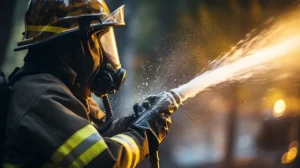By Liz Stevens, writer, UV Solutions
The power and utility of ultraviolet light is undisputed, and the technology can be found in places far and wide. Just when we are sure that every possible base has been covered, someone puts UV to use in another novel way.
Fire and Water
 If there is one commodity that every fire department needs, it is water. In Wales, one fire and rescue service is testing the idea of using treated wastewater to fight fires. With clean, potable water becoming as scarce there as it is elsewhere across the globe, the Mid and West Wales Fire and Rescue Service, in partnership with Dŵr Cymru Welsh Water and Natural Resources Wales, is tapping ultraviolet (UV tertiary) -treated effluent water for putting out fires.
If there is one commodity that every fire department needs, it is water. In Wales, one fire and rescue service is testing the idea of using treated wastewater to fight fires. With clean, potable water becoming as scarce there as it is elsewhere across the globe, the Mid and West Wales Fire and Rescue Service, in partnership with Dŵr Cymru Welsh Water and Natural Resources Wales, is tapping ultraviolet (UV tertiary) -treated effluent water for putting out fires.
Filling fire truck tenders from this type of source gives Welsh firefighters expanded and distributed locations for getting water, allowing them to use treated wastewater from municipal treatment sites around the country. In addition to giving firefighters quicker access to water sources, the measure also will lessen the instances of firefighters using so much of a community’s water supply to douse a fire that the area subsequently experiences low water pressure.
For more information on the initiative, visit https://nation.cymru/news/welsh-fire-service-to-use-wastewater-to-tackle-fires/.
Going Solar
While the Welsh firefighters exhibit their commitment to the environment by conserving precious water, engineers in the US are employing ultraviolet light as part of their effort to build a better solar cell and make electrical power renewable.
Engineers at the Massachusetts Institute of Technology are working to make energy generation more flexible, literally. By using semiconducting inks and scalable printing processes, the engineers create solar cells that are thinner than a human hair. The cells are attached to an ultra-strong fabric with UV-curable glue, resulting in a flexible, light-as-a-feather but tough-as-nails form of solar cells that can be deployed in a wide range of configurations.
The flexibility and drapability of solar cell-covered fabric allows it to turn almost any surface into a power generating source. These solar cells generate more energy than traditional cells – to the tune of nearly 20 times more energy – and, due to their fabric substrate, they can be rolled up, transported and unrolled hundreds of times with minimal loss of generating power.
For more info and a short video of this electrifying innovation, visit https://interestingengineering.com/ie-originals/ie-explainer/season-4/ep-24-mit-makes-a-super-thin-solar-cell-that-can-turn-any-surface-into-a-power-plant.
Raise a Tankard to This Idea
To counter the notion that ultraviolet technology is a rather dry and sober topic, some innovative geeks have busted that myth by brewing craft beer with UV-disinfected water. There is a growing number of US-based brewers teaming up with utility companies, engineering firms and tech companies to turn recycled wastewater into refreshing beer.
One San Francisco tech company that specializes in water treatment and reuse, Epic Cleantec, partnered with Devil’s Canyon Brewing Company and sourced greywater from a Bay Area high-rise apartment building. After disinfection via Epic Cleantec’s OneWater™ system, which included a UV and chlorine step, Devil’s Canyon Brewing used the water to create Epic OneWater Brew. This beer, a Kölsch, reportedly features a crisp golden hue and a fruity taste. It was served at Greenbuild, a sustainable building conference, to demonstrate the high quality and indisputable drinkability of recycled greywater.
(Heads up to would-be home brewers of this – or any – craft beer. The same UV used in technology to disinfect water can, in other settings, wreak havoc on brewski. Perfectly delicious beer turns skunky when ultraviolet light interacts with the hops compounds in the brew. Aluminum cans block UV light and so does brown glass, but clear and green glass bottles are no protection for a beer under UV light or out in the sunshine.)
For more information on recycling greywater and creating this unique category of craft beer, check out the New York Times overview article at https://www.nytimes.com/2023/07/22/business/beer-recycled-wastewater.html or visit the Pure Water Brewing Alliance at https://www.wef.org/topics/practice-areas/water-and-wastewater-treatment/reuse-beer/.





